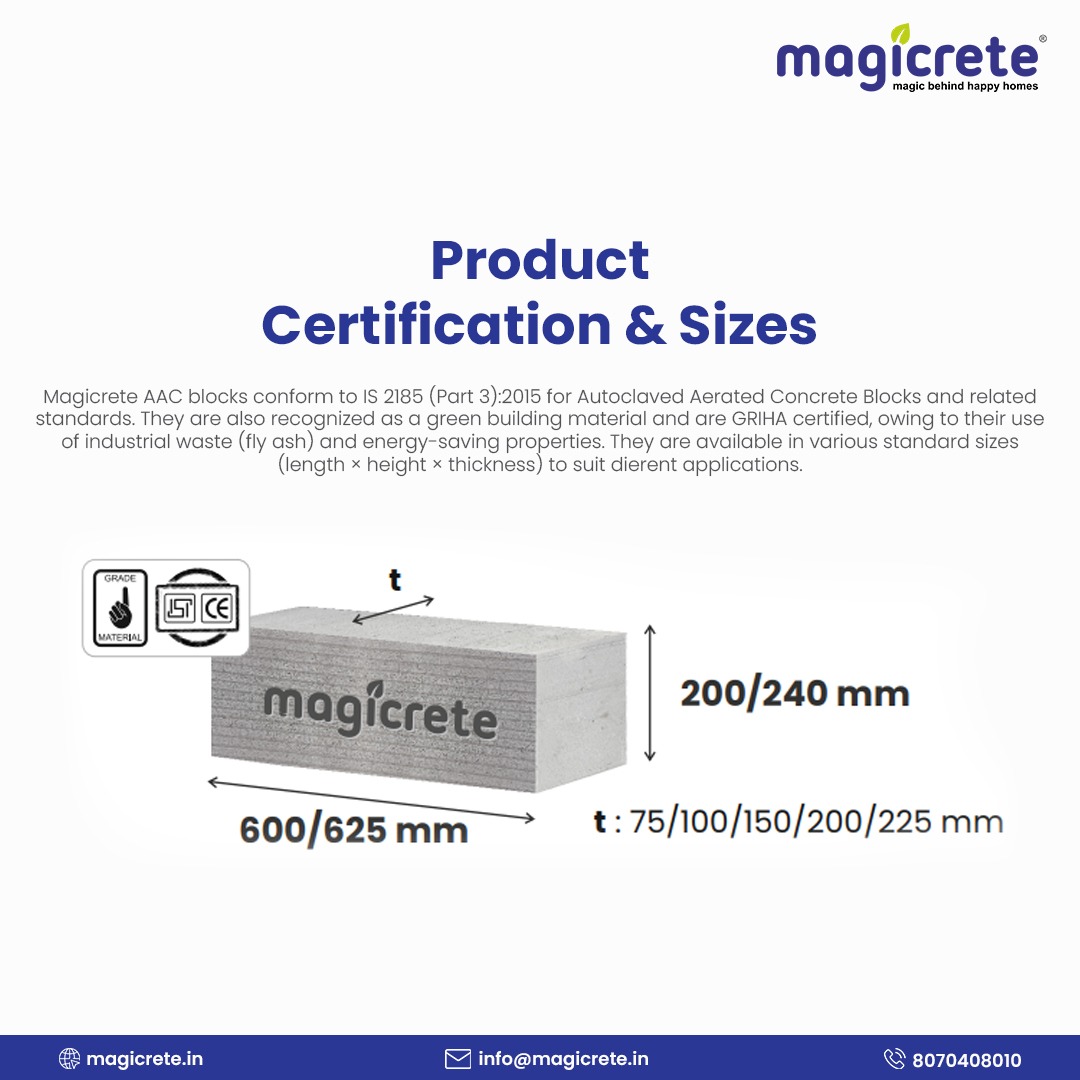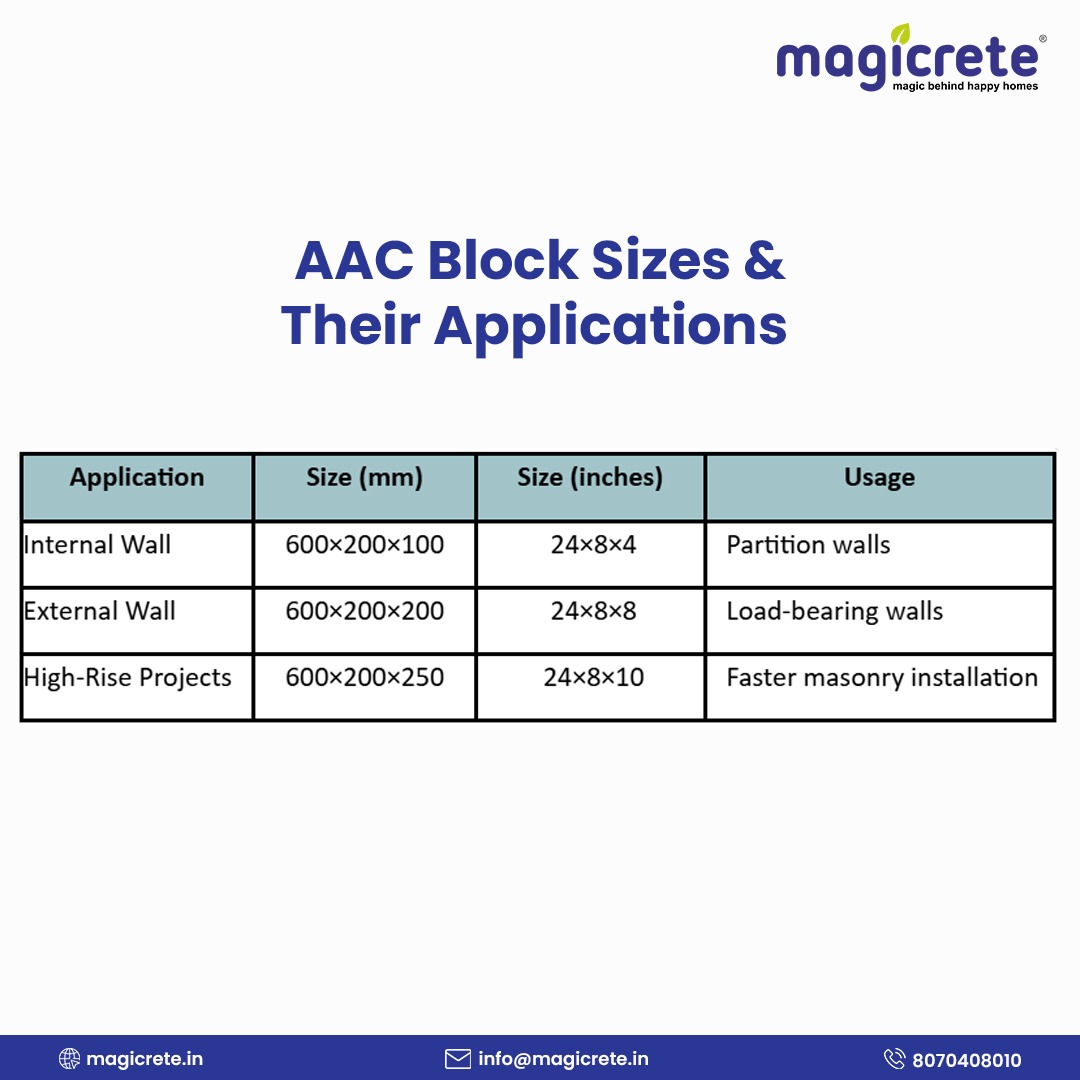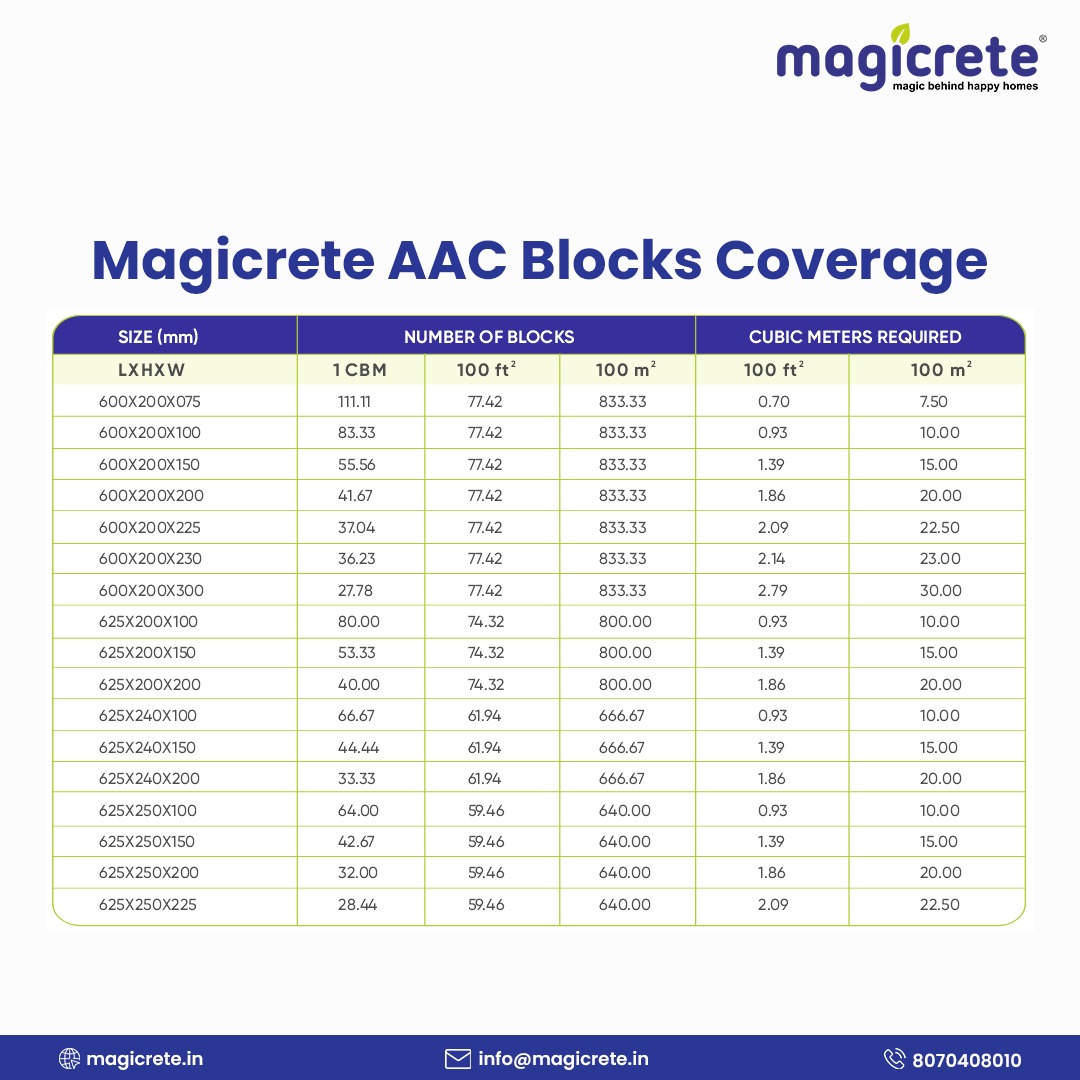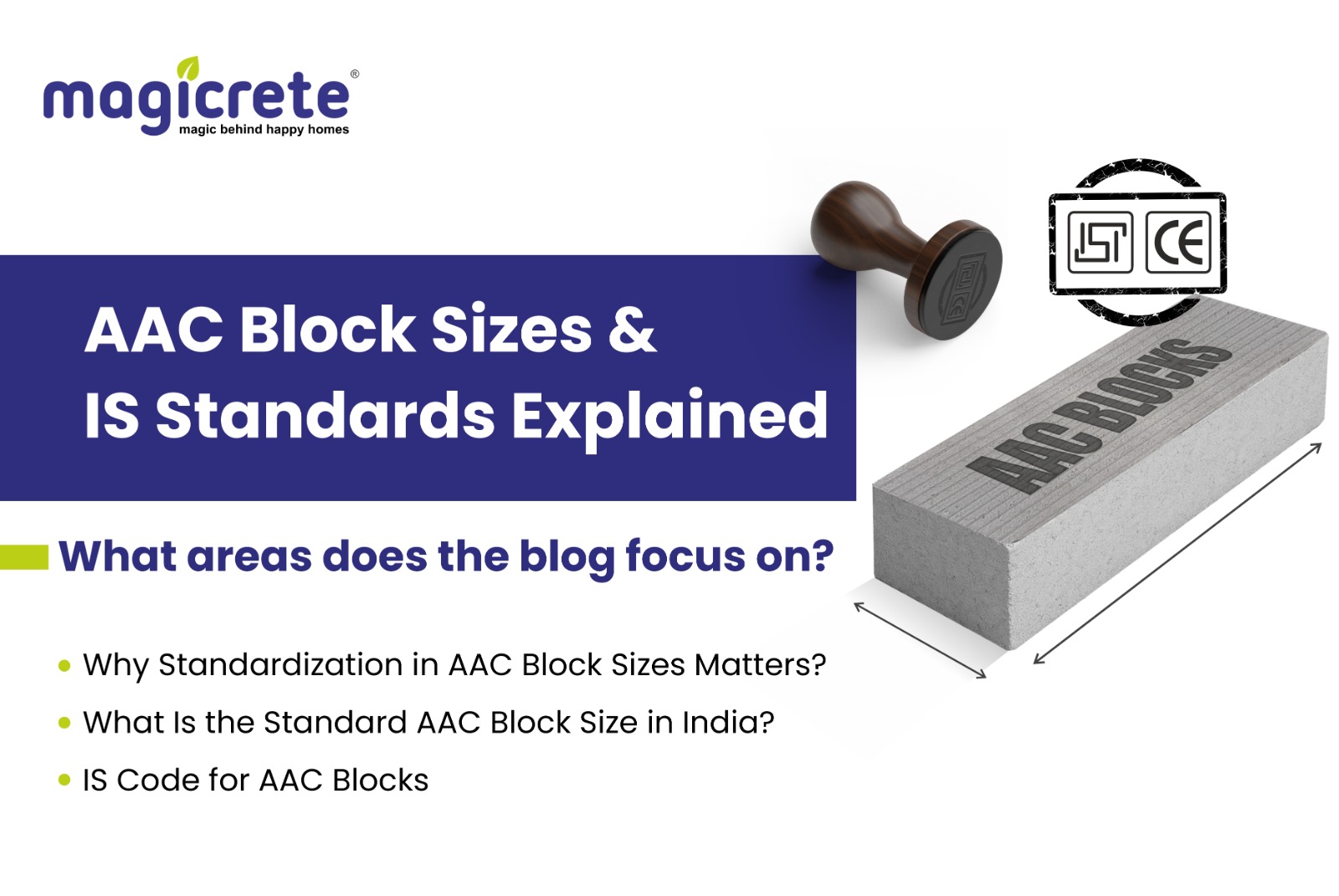Why Standardization in AAC Block Sizes Matters?
The foundation of any successful construction project lies in precision and quality. As a leading manufacturer committed to delivering superior building materials, we consistently observe the challenges faced in the Indian construction landscape due to inconsistent AAC block sizes. As more projects adopt RERA compliance and fast-track construction timelines, standardization in AAC block sizes has become non-negotiable.
- Inconsistent block dimensions can lead to several critical issues:
- Increased mortar consumption at joints
- Labor inefficiencies and rework
- Structural integrity concerns
- Finishing issues when applying plaster or cladding
At Magicrete, our commitment to quality ensures standardized AAC block sizes, guaranteeing precision in construction, allowing for better planning, reduced material wastage, and significantly improved project timelines.
Learn more in our AAC Blocks Guide for detailed insight into AAC product applications and standards.
What Is the Standard AAC Block Size in India?
The standard AAC block size in India follows the specifications outlined in IS 2185 (Part 3) - 1984 (Reaffirmed 2020). The most commonly used dimensions across residential and commercial projects are 600mm × 200mm × (100-250mm).

According to the IS code, the nominal dimensions can also include blocks of lengths 400mm and 500mm, heights of 200mm, 250mm, or 300mm, and widths of 100mm, 150mm, 200mm, or 250mm. Additionally, half-length blocks (200mm, 250mm, or 300mm) are manufactured to correspond with full-length blocks for greater flexibility in construction.
Looking for custom AAC block dimensions?
Talk to Our Experts →
IS Code for AAC Blocks (And Why Compliance Is Non-Negotiable)
Autoclaved Aerated Concrete Blocks, governed by IS 2185 (Part 3) - 1984 (Reaffirmed 2020), are widely used in India due to their strength, thermal efficiency, and compliance with modern construction standards. This standard covers critical parameters including:
- Dimensional tolerances (±5mm in length, ±3mm in height and width)
- Compressive strength requirements (ranging from 2.0-7.0 N/mm² based on density)
- Block density classifications (451-1000 kg/m³)
- Thermal conductivity values
- Drying shrinkage limits
Non-compliance with these standards can lead to serious construction defects. When sourcing AAC blocks, site engineers and project managers should verify:
- Manufacturer’s IS certification
- Block density and grade marking
- Manufacturing date to ensure freshness
- Dimensional accuracy through sample testing
Lower-cost manufacturers often bypass these standards, resulting in blocks that may have inadequate strength, poor dimensional stability, or excessive moisture absorption, all of which compromise the building’s quality and durability.
AAC Block Size Variants by Application
Different construction applications require specific AAC block dimensions for optimal performance:
Residential Homes
For internal partition walls in homes, 600×200×100mm blocks provide adequate sound insulation while maximizing usable floor space. External walls typically use 600×200×200mm blocks for better thermal insulation and load-bearing capacity,
As highlighted in our blog on thermal insulation benefits of AAC blocks.
Commercial Buildings
Commercial structures often utilize 600×200×200mm blocks for both internal and external walls due to their superior fire resistance (4-6 hours depending on thickness) and sound attenuation properties.
Specialized Applications
- Elevator shafts and utility ducts: Narrower blocks with heights of 300mm for faster installation
- Acoustic barriers: Thicker blocks (250mm) with specialized density for sound dampening
- Thermal insulation zones: Lower density blocks (500-600 kg/m³) with thickness of 200-250mm

Quick Size Reference Chart for Project Planning
When estimating materials for your project, refer to this quick reference:
Block Size (mm) | Coverage per block (m²) | Blocks per m² | Weight per block (kg)* |
600×200×100 | 0.12 | 8.33 | 15-20 |
600×200×150 | 0.12 | 8.33 | 20-25 |
600×200×200 | 0.12 | 8.33 | 25-35 |
600×200×250 | 0.12 | 8.33 | 35-40 |

*Weight varies based on block density (typically 600-800 kg/m³ for standard construction)
Conclusion: Precision Sizing Means Better Structures
Standardization in AAC block sizes isn’t merely a technical specification, it’s a foundation for construction excellence. By adhering to IS 2185 standards, builders ensure structural integrity, thermal efficiency, and construction economy. The dimensional accuracy of AAC blocks translates directly to reduced material wastage, faster construction cycles, and better finished quality.
For your next construction project, insist on IS-certified AAC blocks from Magicrete that meet standard dimensions. The initial diligence in selecting properly sized blocks will pay dividends throughout the construction process and the building’s lifetime. You can find nearest AAC Block dealers or contact us for expert guidance.
Frequently Asked Questions
How many AAC blocks per m²?
On an average, 8 AAC blocks (600x200x100mm) are required per square meter of walling. This may vary slightly based on block size and joint thickness.
What is the standard AAC block size for internal walls?
The standard AAC block size for internal partition walls is 600mm x 200mm x 100mm, ensuring lightweight yet sturdy construction.
Which IS code governs AAC blocks in India?
AAC blocks are governed by IS 2185 (Part 3): 1984, which covers autoclaved cellular concrete blocks’ specifications and performance.
What is the AAC block thickness for external walls?
For external walls, 150mm to 200mm thick AAC blocks are typically recommended to ensure structural strength and better insulation.
Can I get AAC blocks in custom sizes for duct walls?
Magicrete AAC Blocks come in a variety of thicknesses, making them ideal for non-load-bearing duct walls where space optimization is critical.
Is AAC block better than red brick?
Yes. AAC blocks are lighter, more thermally efficient, and faster to install compared to red bricks. They also reduce overall construction costs by lowering mortar and steel usage. However, red bricks may still be used in low-cost rural projects where AAC supply is limited.
What are the disadvantages of AAC blocks?
While AAC blocks offer many benefits, their disadvantages include:
- Slightly higher initial cost compared to clay bricks in some regions
- Requirement of skilled labor for proper block laying
- Brittle nature (requires careful handling during transport)
- Limited availability in some rural markets outside metro regions
What is the price of AAC blocks per m³ in India (2025)?
As of 2025, AAC block prices in India range from ₹3,500–₹4,000 per cubic meter, depending on density, size, and region. Prices may vary slightly across states such as Gujarat, Maharashtra, Tamil Nadu, and West Bengal.
How strong are AAC blocks compared to bricks?
AAC blocks typically have a compressive strength of 2–7 N/mm² depending on density, which is adequate for both residential and commercial buildings. While traditional red bricks may reach similar strength, AAC blocks offer superior fire resistance, acoustic insulation, and thermal efficiency.
Content
- Why Standardization in AAC Block Sizes Matters?
- What Is the Standard AAC Block Size in India?
- IS Code for AAC Blocks (And Why Compliance Is Non-Negotiable)
- AAC Block Size Variants by Application
- Quick Size Reference Chart for Project Planning
- Conclusion: Precision Sizing Means Better Structures
- Frequently Asked Questions



